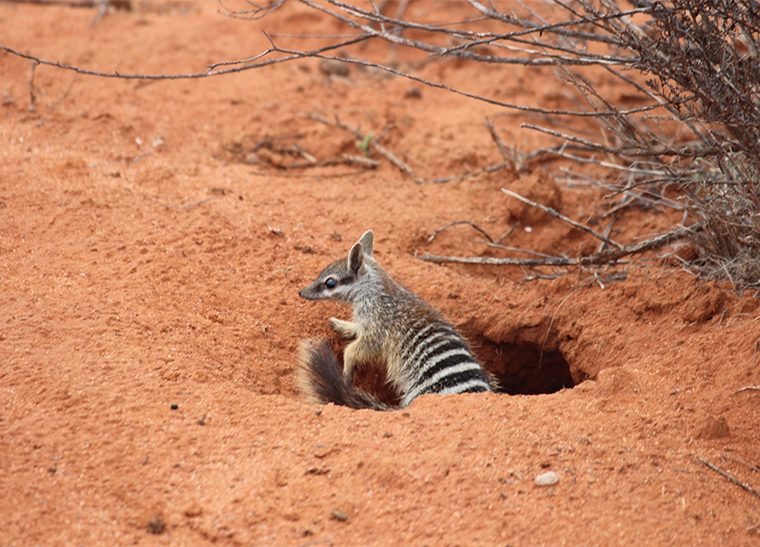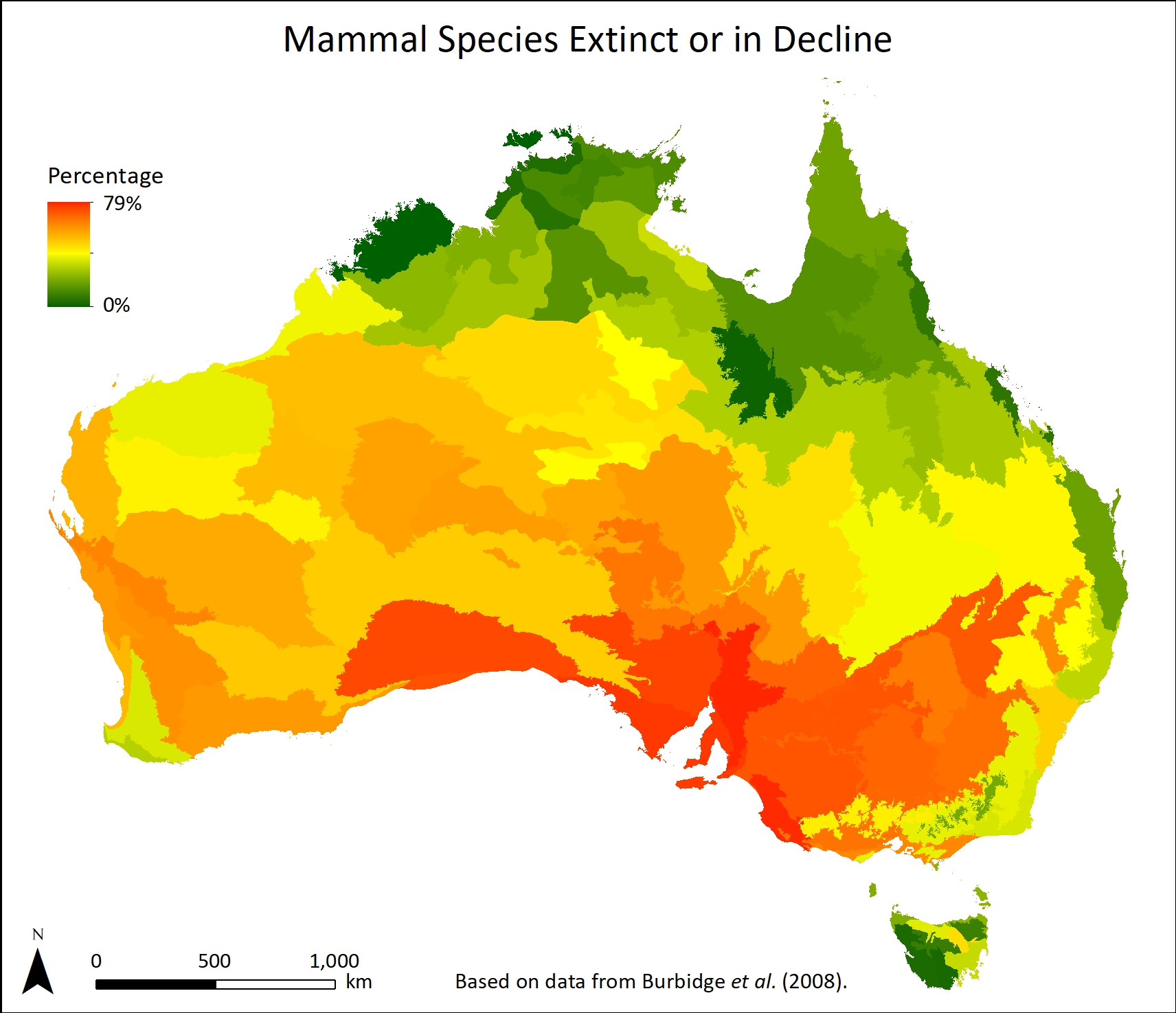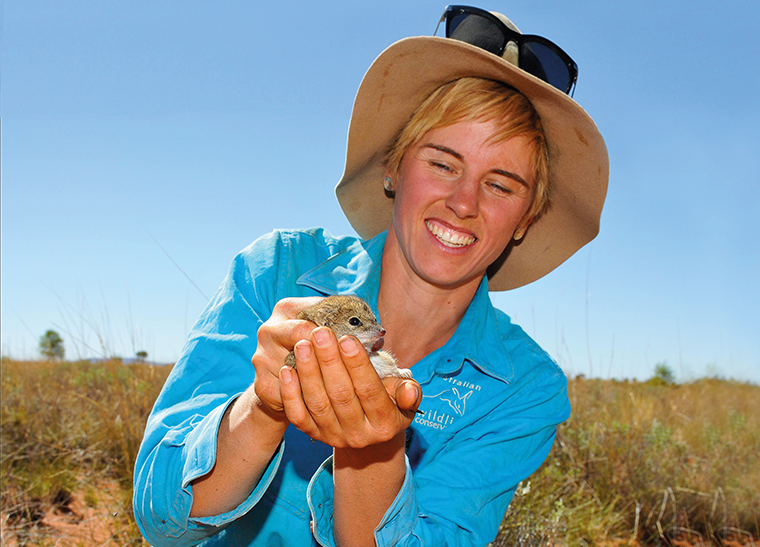By Dr John Kanowski, Chief Science Officer
Australian Wildlife Conservancy is a leader in the reintroduction of threatened mammals to secure, feral predator-free areas. To date, AWC’s reintroduction program has resulted in the establishment of secure populations of 11 species of threatened mammals across a total of five feral predator-free areas (Faure Island, WA, and four fenced areas – Karakamia, Mt Gibson, Yookamurra and Scotia). A further three fenced areas – at Newhaven, Pilliga and Mallee Cliffs – are on target to become fully operational in 2019. Together with the existing program, reintroductions of locally-extinct mammals to the new sites are expected to secure populations of 21 species of threatened mammals by 2023.
 © Wayne Lawler/AWC
© Wayne Lawler/AWC
Predation by feral cats and foxes is the primary cause of extinction of small to medium-sized native mammals. Many mammal species in the ‘critical weight range’– between 35 grams (the size of a native rodent) to 5.5 kilograms (the size of a small wallaby) – have been eliminated from large areas of their former ranges. As a consequence, much of southern and central Australia is devoid of most native terrestrial mammals between the size of a mouse and a kangaroo (See map below).
Some species, such as the Lesser Bilby (Macrotis leucura) which is AWC’s emblem, the Pig-footed Bandicoot (Chaeropus ecaudatus) and Crescent Nailtail Wallaby (Onychogalea lunata), are completely extinct. Others, including the Greater Bilby (Macrotis lagotis), Numbat (Myrmecobius fasciatus) and Bridled Nailtail Wallaby (Onychogalea fraenata), still persist in the wild, but in a fraction of their former range.
The extinction and decline of mammals within the critical weight range represents a shocking degradation of Australia’s biological riches and has resulted in the decay of long-standing ecological processes. Many small to medium- sized native mammals are‘ecosystem engineers,’ digging deep pits when foraging and burrows for resting. These diggings help retain precious surface water and nutrients in semi-arid ecosystems. In addition, the foraging activities of native mammals affects the abundance of soil and leaf litter invertebrates, the fate of seeds and the recruitment of plants. The loss of native mammals, such as the Bilby and Numbat, therefore constitutes a loss of ecosystem integrity. Trees and shrubs may persist in the landscape, but the processes that have been integral to the formation of the Australian bush have invisibly slipped away across much of the continent.
AWC’s reintroduction programs
AWC has already undertaken the successful reintroduction of 11 threatened mammal species to five sites – more than any other organisation in Australia. Recent AWC projects have set new benchmarks in rewilding with, for example, eight threatened mammal species restored to Mt Gibson, and similarly ambitious, multi-species projects planned for Pilliga, Mallee Cliffs and Newhaven.
Halting and restoring Australia’s lost biodiversity
AWC’s reintroduction programs are successfully restoring populations of native mammals that are most vulnerable to predation by feral cats and foxes. For example, AWC sanctuaries currently support secure populations of six of the 12 species of Australian mammals considered ‘extremely vulnerable’ to feral cats and foxes (Radford et al. 2018), with a seventh species – the Central Rock-rat (Zyzomys pedunculatus) – proposed for reintroduction to AWC’s Newhaven project. In addition, AWC’s reintroduction program currently supports secure populations of nine of the 51 species of Australian mammals considered ‘highly vulnerable’ to feral cats and foxes, with another four species – Western Quoll (Dasyurus geoffroii), Golden Bandicoot (Isoodon auratus), Northern Bettong (Bettongia tropica) and Plains Mouse (Pseudomys australis) – proposed for reintroduction to one or more of AWC’s rewilding projects.
 © Tani Cooper/AWC
© Tani Cooper/AWC
AWC’s reintroduction program is one of Australia’s few stand-out success stories in the conservation of native mammals. For example:
• The Greater Bilby has been reduced to fewer than 10,000 individuals in the wild (Woinarski et al. 2014). AWC has reintroduced the Bilby to four feral predator-free areas (including to the Pilliga where they have been absent for more than 100 years). Further reintroductions of Bilbies to two new sites are planned over the next two years. Collectively, AWC’s fenced areas currently support around 1,500 Bilbies. This number is expected to double as new projects mature.
• The Numbat, reduced to fewer than 1,000 individuals in remnant populations in south-west Australia, has been reintroduced to three of AWC’s feral predator-free areas (with another two planned); these populations currently support 300 to 500 Numbats (up to 50 per cent of the global population), with a similar number expected to be added in AWC’s new projects.
• The Bridled Nailtail Wallaby has been reduced to one remnant population, of around 500 individuals, at Taunton National Park in Queensland. AWC’s Scotia Wildlife Sanctuary supports around 1,000 individuals. Reintroductions planned to fenced areas at Pilliga and Mallee Cliffs in 2019 and 2020, respectively, are each expected to support populations of a similar size.
 © Wayne Lawler/AWC
© Wayne Lawler/AWC
AWC’s reintroduction program also contributes to the restoration of ecological processes at each site. At Scotia the many signs of animal activity within the fenced area can be clearly seen as the populations of Bilbies, Bettongs and Numbats dig burrows and excavate foraging pits. As AWC’s reintroduction projects mature, we expect to see a similar restoration of the soils and ecosystem processes at other sites.
AWC ecologists are measuring key variables, including diggings, as part of our Ecohealth monitoring program. In addition, we are collaborating with a number of external researchers on the restoration of other components of the ecosystem, such as invertebrate assemblages.
A major contribution to biodiversity conservation
AWC’s programs to reintroduce threatened mammals to feral predator-free areas are making a crucial contribution to conservation in Australia by:
• increasing the number of secure populations – and global population size – of threatened mammals;
• restoring regionally-extinct mammals to parts of their former range, thereby helping to maintain the long-term adaptive potential of these species; and
• playing a crucial role in the restoration of Australian ecosystems, as threatened mammals participate in a number of important ecological processes including herbivory, seed and spore dispersal, soil engineering and predation.
The establishment of additional feral predator-free areas is a priority action in the Commonwealth Government’s Threatened Species Strategy and an important component of the conservation strategies of a number of State Governments, including Western Australia and New South Wales.
AWC is by far the leading proponent of the establishment and rewilding of feral predator-free areas in Australia. With AWC’s network of feral predator-free areas rapidly expanding, we have an ambitious plan to undertake 27 translocations of 15 species over the next 12 to 24 months – more translocations than we have previously undertaken in the history of AWC. Indeed, the scale of this translocation program is without parallel in Australia. The future of 21 threatened native mammal species is likely to be secured as a result, representing an astonishing return on investment.